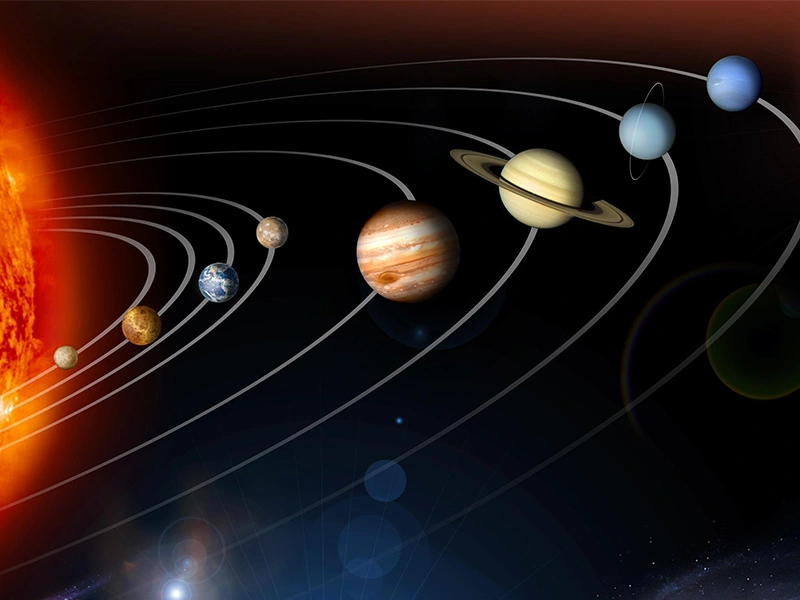The cosmos, an infinite expanse, hosts our awe-inspiring solar system, with its celestial bodies dancing to the rhythm of gravity. Among the wonders of the universe, the distances between these heavenly orbs have always fascinated scientists and space enthusiasts alike.
The Distance From The Sun
This captivating article delves into the average distances of our solar system bodies from the Sun. This journey takes us from astronomical units (AU) to kilometers (KM) and miles (MI).
AU stands for Astronomical Units, 1 AU is equal to 92.96 Million Miles which is the average* distance of The Earth from The Sun.
* Average because due to the epileptic orbit path, this distance changes over the year.
Mercury
Mercury, the closest planet, basks in the Sun’s warmth from a mere 0.39 AU, equivalent to about 57.91 million kilometers or 35.98 million miles.
Venus
Venturing further, we encounter Venus, the alluring beauty second from the Sun, residing at 0.72 AU, approximately 108.2 million kilometers or 67.24 million miles away.
The Earth
Astonishingly, our home planet Earth rests perfectly at 1 AU, encompassing an average distance of 149.6 million kilometers or 92.96 million miles from the Sun, a cosmic coincidence that sustains life.
Mars
Mars, the “Red Planet,” orbits at a distance of 1.52 AU, approximately 227.9 million kilometers or 141.6 million miles from the life-giving star.
Jupiter
As we journey into the outer reaches, a behemoth appears – Jupiter, the mighty gas giant, reigning from a formidable 5.20 AU, encompassing about 778.3 million kilometers or 483.8 million miles of space.
Saturn
Next in line is Saturn, known for its majestic rings, majestically hovering at 9.58 AU, occupying a distance of approximately 1.43 billion kilometers or 889.7 million miles.
Uranus
Uranus, the enigmatic ice giant, stands at 19.22 AU, equivalent to about 2.87 billion kilometers or 1.78 billion miles away, marking the beginning of the distant solar frontier.
Neptune
Neptune, the final gas giant, presides over its domain at 30.05 AU, stretching about 4.50 billion kilometers or 2.79 billion miles from the fiery grasp of the Sun.
Pluto
And last but not least, Pluto, once a planet, now a dwarf planet, resides at the fringes of our solar system, a distant 39.48 AU, encompassing a vast 5.91 billion kilometers or 3.67 billion miles.
Conclusion (table)
Each celestial body in our solar system has found its unique place, dancing in the cosmic ballet, guided by the celestial laws of gravity and motion. The distances between these worlds showcase the grandeur and complexity of our cosmic neighborhood.
As we continue to explore and study our solar system, these measurements provide invaluable insights into the universe’s secrets, fueling our curiosity and pushing the boundaries of human knowledge.
So, let us marvel at the intricacies of our cosmic dance, a symphony of distances connecting us to the heavens, reminding us that in the vastness of space, our solar system remains a mesmerizing spectacle of celestial harmony.
| Solar System Body | AU (Astronomical Units) | KM (Kilometers) | MI (Miles) |
|---|---|---|---|
| Mercury | 0.39 AU | 57.91 million km | 35.98 million mi |
| Venus | 0.72 AU | 108.2 million km | 67.24 million mi |
| Earth | 1 AU | 149.6 million km | 92.96 million mi |
| Mars | 1.52 AU | 227.9 million km | 141.6 million mi |
| Jupiter | 5.20 AU | 778.3 million km | 483.8 million mi |
| Saturn | 9.58 AU | 1.43 billion km | 889.7 million mi |
| Uranus | 19.22 AU | 2.87 billion km | 1.78 billion mi |
| Neptune | 30.05 AU | 4.50 billion km | 2.79 billion mi |
| Pluto | 39.48 AU | 5.91 billion km | 3.67 billion mi |
Please note that the distances mentioned here are approximate average values and can vary due to the elliptical orbits of the planets.
Also, it’s worth mentioning that astronomical units (AU) are a convenient unit of measurement for interplanetary distances, as they are based on the average distance between the Earth and the Sun (about 149.6 million kilometers or 92.96 million miles).
Read more about the solar system: A Concise Resume About The Solar System Facts.





